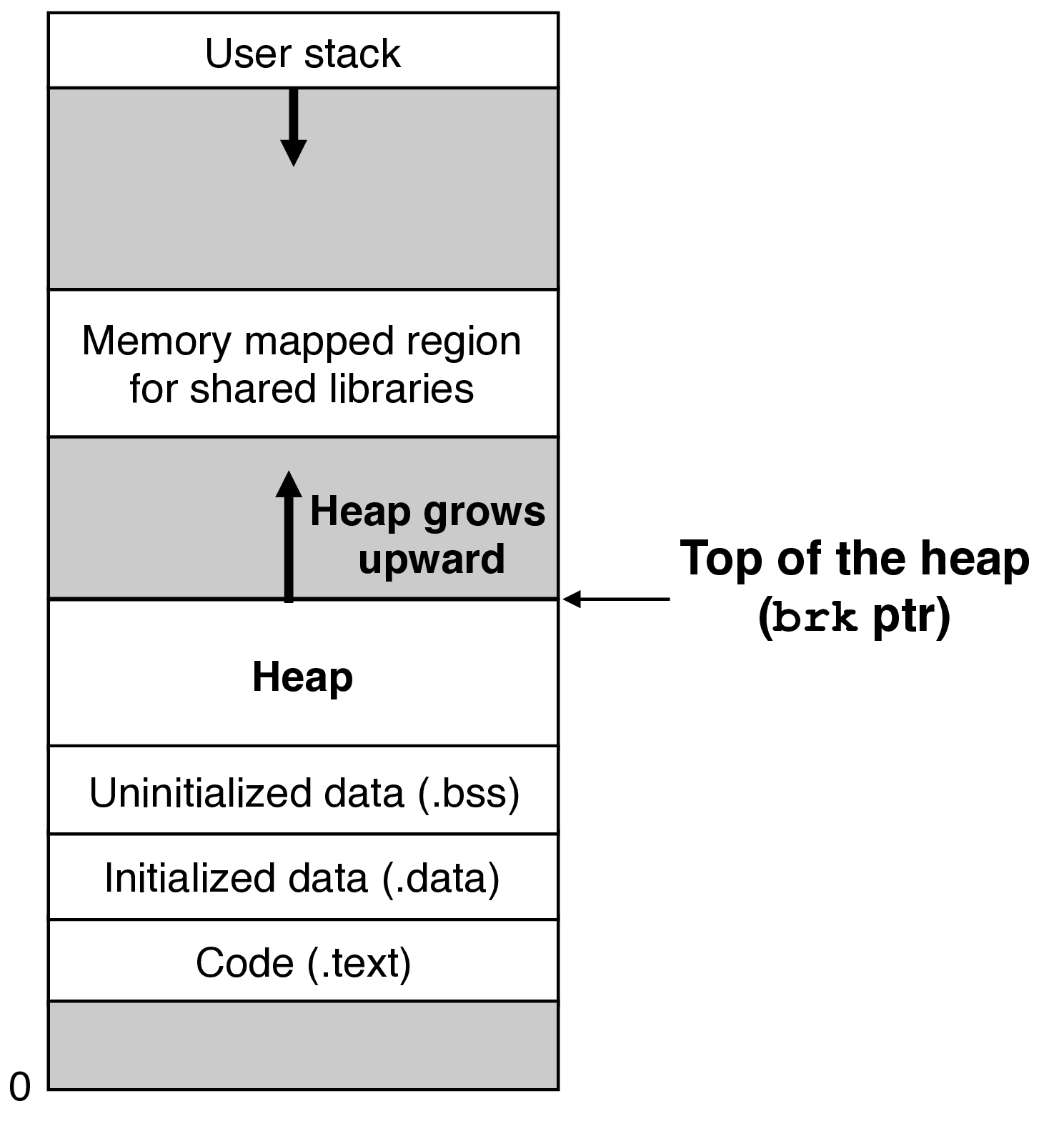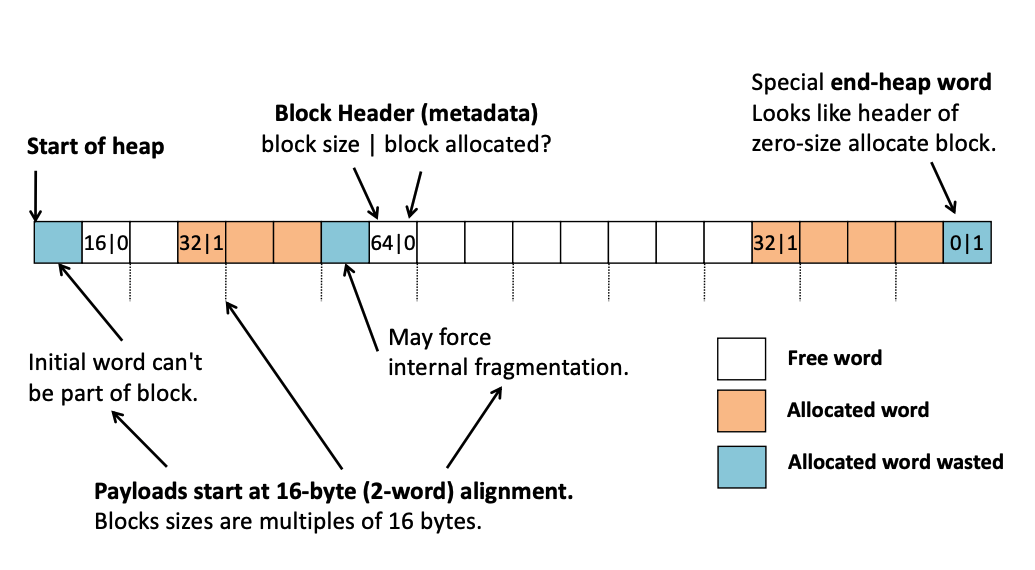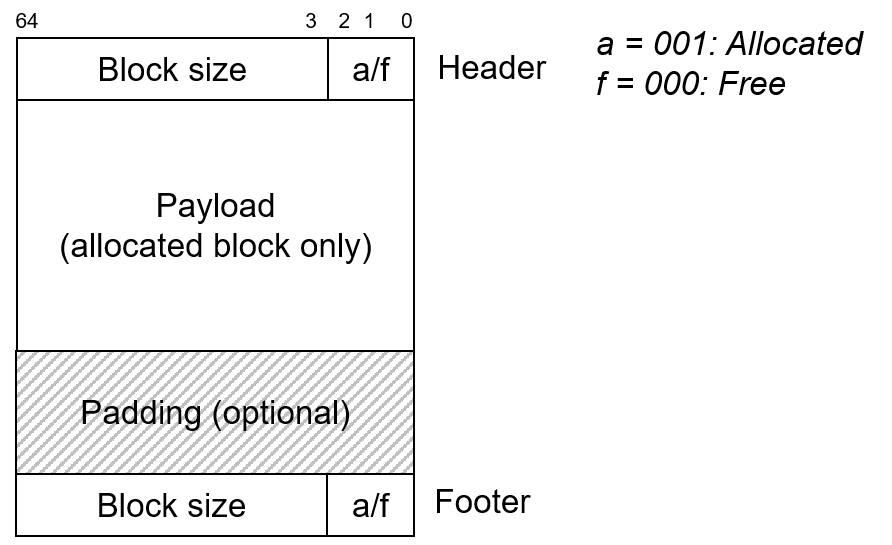CS 208 w20 lecture 20 outline
1 Introduction
// static global data, size fixed at compile time, exists for the lifetime of the program int array[1024]; void foo(int n) { // stack-allocated data, known lifetime (deallocated on return) int tmp; int local_array[n]; // some versions of C allow dynamically-sized stack allocation // dynamic (heap) data, size and lifetime known only at runtime int* dyn = (int*) malloc(n * sizeof(int)); // good practices: // sizeof makes code more portable // void* is implicitly cast into any pointer type; explicit typecast will help you // catch coding errors when pointer types don’t match }
Two big questions we'll focus on for the next two weeks:
- how do we manage the scarce resource of physical memory while providing all processes as much virtual memory as they need?
- implemented by the operating system kernel and hardware
- how do we handle
mallocandfreequickly and efficiently?- implemented by the C library
Lab 5 will task you with doing 2., so we will start there.
2 Dynamic Memory Allocation
We don't always know how much space we will need for certain data structures, etc. ahead of time. Hardcoded sizes everywhere can lead to problems and become a maintenance nightmare. Hence, we wany the ability to allocate memory as we go along (dynamically)
2.1 Type of Allocators
- Allocator organizes heap as a collection of variable-sized blocks, which are either allocated or free
- explicit allocators: require manual requests and frees (
mallocpackage in C) - implicit allocators: unused blocks are automatically detected and freed (garbage collection)
2.1.1 malloc package
mallocdoes no initialization, usecallocto request zero-initialized memory- returns pointer to the beginning of allocated block,
NULLindicates failed request - typically 16-byte aligned on x86-64
- returns pointer to the beginning of allocated block,
- change the size of previously allocated block with
realloc - underneath, allocation can use
mmapandmunmapor use thevoid *sbrk(intptr_t incr)functionsbrkgrows or shrinks the heap by addingincrto the kernel'sbrkpointer, returns old value ofbrk

freetakes a pointer to the beginning of a block previously allocated bymalloc,calloc, orrealloc- behavior undefined on other arguments, no indication of error
2.2 Spreadsheet Example
2.3 Allocator Goals and Requirements
2.3.1 Requirements
- handling arbitrary request sequences: cannot make any assumptions about the sequencing of allocate and free requests
- making immediate responses to requests: no reordering or batching of requests to improve performance
- using only the heap: allocator's internal data structures must also be stored on the heap
- aligning blocks: blocks need to meet alignment requirements for any type of data they might hold
- not modifying allocated blocks: cannot modify or move blocks when they are allocated
2.3.2 Goals
- maximizing throughput: maximize requests per second
- maximizing memory utilization: use the greatest possible fraction of the space allocated for the heap. Peak utilization metric is the maximum such fraction achieved over the course of \(n\) requests.
- these are in tension: respond to a request faster vs respond with a better choice of block
2.4 Fragmenataion
- internal fragmentation: allocated block is larger than the amount requested (due to minimum block size or alignment requirements)

- POLL
- external fragmentation: when allocation/free pattern leaves "holes" between blocks
- symptom: there is enough total free memory to satisfy a request, but no single free block is large enough
- example: if final request on spreadsheet example were for 48 bytes
- difficult to quantify as it depends on future requests
- POLL
2.5 Implementation Issues
- free block organization: how to keep track of them
- placement: which free block should we choose to fulfill a request
- splitting: what do we do with the remainder of a free block after part of it is allocated
- coalescing: what do we do when a block is freed
2.6 Implicit Free Lists


- since block size will always be a multiple of 16 due to alignment, the four lower order bits of the size will always be 0
- we can make efficient use of the header by using these four bits to indicate if the block is allocated or free
- the block size includes the payload and any padding, and is thus an implicit pointer to the start of the next block
- we will need some special block to mark the end of the free list (e.g, allocated bit, size 0)
- implicit free list is simple, but operations are linear in the number of blocks since we have to traverse the list
- alignment combined with block format impose a minimum block size
2.7 Placing Allocated Blocks
- an allocator's placement policy determines the choice of free block to fulfill allocation
- first fit: take the first free block that's big enough
- end up with lots of small "splinters" near the start of the list, large blocks near the end
- next fit: like first fit, but start search where the previous one left off
- unclear if this is better than first fit in practice
- best fit: choose the smallest free block that fits
- better memory utilization, but requires exhaustive search
- first fit: take the first free block that's big enough
- if the fit is not good, an allocator might opt to split the free block into two parts
- if necessary, an allocate will ask the kernel for additional heap memory, inserting a new free block into the list
2.8 Coalescing Free Blocks
- adjacent free blocks cause false fragmentation—free memory chopped up into many small unusable free blocks
- to address this an allocator must merge (coalesce) adjacent free blocks
- immediate coalescing: merge blocks whenever one is freed
- simple, constant time
- can lead to a form of thrashing where a block is coaslesced and split repeatedly
- deferred coalescing: wait and coaslesce at a later time (e.g., scan the hope when a request fails)
- often the more efficient choice
- immediate coalescing: merge blocks whenever one is freed
2.8.1 Boundary Tags
- with a simple header containing the block size, we can reach the next block, but what about the previous block?
- we'd have to traverse the free list until we reached the current block
- instead, add a footer to each block that's the same as the header
- together, the header and footer form boundary tags
- if we go back one word from the header, we get to the footer of the previous block

- four cases for coalescing:
- previous and next blocks are both allocated
- previous block is allocated, next block is free
- previous block is free, next block is allocated
- previous and next blocks are both free
- boundary tags can introduce significant memory overhead in the case of many small blocks
- fortunately, we only need to have footers in free blocks, since we only care about the size of the previous block when it is free and we want to merge it
- we still need a way to tell if the previous block is allocated, so we'll add that information to one of the unused low-order bits of the header